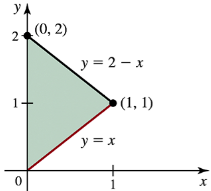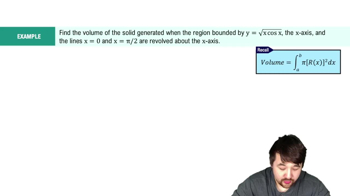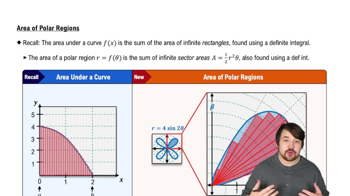Determine the area of the shaded region bounded by the curve x^2=y^4(1−y^3) (see figure).
Table of contents
- 0. Functions7h 54m
- Introduction to Functions16m
- Piecewise Functions10m
- Properties of Functions9m
- Common Functions1h 8m
- Transformations5m
- Combining Functions27m
- Exponent rules32m
- Exponential Functions28m
- Logarithmic Functions24m
- Properties of Logarithms36m
- Exponential & Logarithmic Equations35m
- Introduction to Trigonometric Functions38m
- Graphs of Trigonometric Functions44m
- Trigonometric Identities47m
- Inverse Trigonometric Functions48m
- 1. Limits and Continuity2h 2m
- 2. Intro to Derivatives1h 33m
- 3. Techniques of Differentiation3h 18m
- 4. Applications of Derivatives2h 38m
- 5. Graphical Applications of Derivatives6h 2m
- 6. Derivatives of Inverse, Exponential, & Logarithmic Functions2h 37m
- 7. Antiderivatives & Indefinite Integrals1h 26m
- 8. Definite Integrals4h 44m
- 9. Graphical Applications of Integrals2h 27m
- 10. Physics Applications of Integrals 3h 16m
- 11. Integrals of Inverse, Exponential, & Logarithmic Functions2h 34m
- 12. Techniques of Integration7h 41m
- 13. Intro to Differential Equations2h 55m
- 14. Sequences & Series5h 36m
- 15. Power Series2h 19m
- 16. Parametric Equations & Polar Coordinates7h 58m
9. Graphical Applications of Integrals
Area Between Curves
Problem 6.2.7
Textbook Question
Express the area of the shaded region in Exercise 5 as the sum of two integrals with respect to y. Do not evaluate the integrals.

 Verified step by step guidance
Verified step by step guidance1
Identify the region bounded by the lines \(y = 2 - x\) and \(y = x\), and the vertical line \(x = 1\). The vertices of the shaded triangular region are at points \((0, 2)\), \((1, 1)\), and \((1, 0)\).
Since the problem asks for the area expressed as the sum of two integrals with respect to \(y\), we need to rewrite the boundary curves in terms of \(x\) as functions of \(y\). From \(y = 2 - x\), solve for \(x\): \(x = 2 - y\). From \(y = x\), solve for \(x\): \(x = y\).
Determine the range of \(y\) values for the two parts of the region. The lower part of the region extends from \(y = 0\) to \(y = 1\), and the upper part extends from \(y = 1\) to \(y = 2\).
For \$0 \leq y \leq 1\(, the left boundary is \)x = y\( and the right boundary is \)x = 1\(. So, the area contribution here is the integral \)\int_0^1 (1 - y) \, dy$.
For \$1 \leq y \leq 2\(, the left boundary is \)x = 0\( and the right boundary is \)x = 2 - y\(. So, the area contribution here is the integral \)\int_1^2 (2 - y) \, dy$. The total area is the sum of these two integrals.
 Verified video answer for a similar problem:
Verified video answer for a similar problem:This video solution was recommended by our tutors as helpful for the problem above
Video duration:
2mPlay a video:
Was this helpful?
Key Concepts
Here are the essential concepts you must grasp in order to answer the question correctly.
Setting up integrals with respect to y
When expressing area as integrals with respect to y, the region is sliced horizontally. This requires rewriting the boundary curves as functions of y (i.e., x in terms of y) and integrating over the y-intervals that cover the region. This approach is useful when the region is bounded more naturally by horizontal slices.
Recommended video:

Integration by Parts for Definite Integrals Example 8
Finding inverse functions of boundary curves
To integrate with respect to y, the given functions y = 2 - x and y = x must be inverted to express x as functions of y. For example, from y = 2 - x, we get x = 2 - y, and from y = x, we get x = y. These inverse functions define the horizontal boundaries of the region for integration.
Recommended video:

Derivatives of Other Inverse Trigonometric Functions
Partitioning the region for multiple integrals
The shaded region is divided into two parts along y = 1 because the left and right boundaries change at this point. Each part corresponds to a different pair of boundary functions in terms of y, so the total area is expressed as the sum of two integrals over different y-intervals.
Recommended video:

Area of Polar Regions

 5:23m
5:23mWatch next
Master Finding Area Between Curves on a Given Interval with a bite sized video explanation from Patrick
Start learningRelated Videos
Related Practice
Textbook Question
28
views
